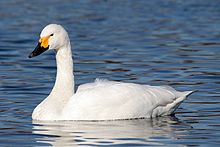Tundra swan
| Tundra swan (Bewick's swan/whistling swan) |
|
|---|---|
 |
|
| Adult Bewick's swan, Cygnus columbianus bewickii
Recorded in Gloucestershire, England
|
|
| Scientific classification | |
| Kingdom: | Animalia |
| Phylum: | Chordata |
| Class: | Aves |
| Superorder: | Galloanserae |
| Order: | Anseriformes |
| Family: | Anatidae |
| Subfamily: | Anserinae |
| Tribe: | Cygnini |
| Genus: | Cygnus |
| Species: | C. columbianus |
| Binomial name | |
|
Cygnus columbianus (Ord, 1815) |
|
| Subspecies | |
|
C. c. bewickii (Yarrell, 1830), Bewick's swan |
|
| Synonyms | |
|
Anas columbianus Ord, 1815 |
|
C. c. bewickii (Yarrell, 1830), Bewick's swan
C. c. columbianus (Ord, 1815), whistling swan
Anas columbianus Ord, 1815
Cygnus bewickii (Yarrell, 1838)
Cygnus bewickii jankowski (lapsus)
Cygnus bewickii jankowskii
Cygnus columbianus jancowskii (lapsus)
Cygnus columbianus jankowskii
Olor bewickii (Yarrell, 1838)
Olor columbianus (Ord, 1815)
The tundra swan (Cygnus columbianus) is a small Holarctic swan. The two taxa within it are usually regarded as conspecific, but are also sometimes split into two species: Bewick's swan (Cygnus bewickii) of the Palaearctic and the whistling swan (C. columbianus) proper of the Nearctic. Birds from eastern Russia (roughly east of the Taimyr Peninsula) are sometimes separated as the subspecies C. c. jankowskii, but this is not widely accepted as distinct, most authors including them in C. c. bewickii. Tundra swans are sometimes separated in the genus Olor together with the other Arctic swan species.
Bewick's swan was named in 1830 by William Yarrell after the engraver Thomas Bewick, who specialised in illustrations of birds and animals.Cygnus is the Latin for "swan", and columbianus comes from the Columbia River, the type locality.
C. columbianus is the smallest of the Holarctic swans, at 115–150 cm (45–59 in) in length, 168–211 cm (66–83 in) in wingspan and a weight range of 3.4–9.6 kg (7.5–21.2 lb). In adult birds, the plumage of both subspecies is entirely white, with black feet, and a bill that is mostly black, with a thin salmon-pink streak running along the mouthline and – depending on the subspecies – more or less yellow in the proximal part. The iris is dark brown. In birds living in waters that contains large amounts of iron ions (e.g. bog lakes), the head and neck plumage acquires a golden or rusty hue. Pens (females) are slightly smaller than cobs (males), but do not differ in appearance otherwise.
...
Wikipedia

